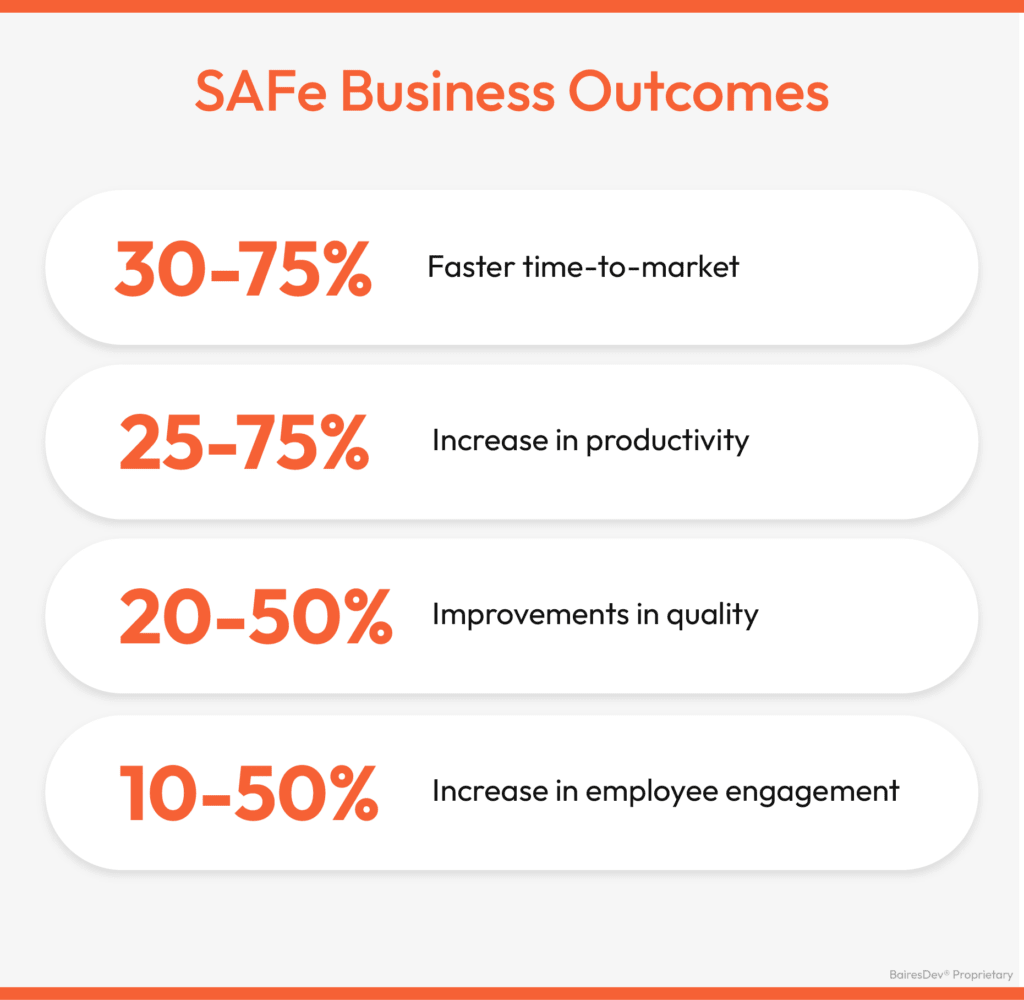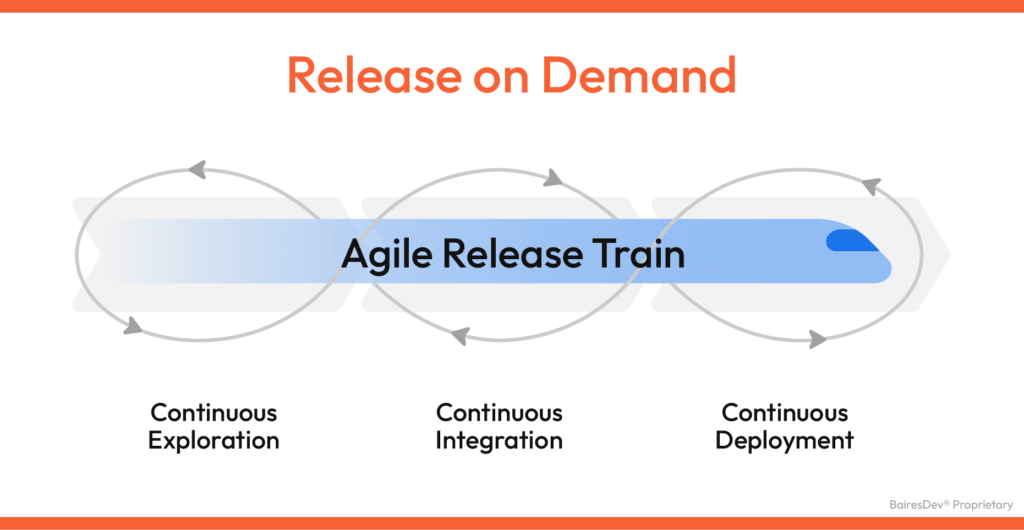Agile has proven fundamental in software development—but it’s not easy to implement at the enterprise level where multiple teams depend on each other. If you have various teams working on different aspects of the same product, keeping them in sync can be difficult. Enter the Scaled Agile Framework (SAFe), a set of organization and workflow patterns for implementing agile practices at an enterprise scale.
Developed by Dean Leffingwell in 2011, SAFe addresses the alignment issues faced by large organizations using Agile teams. It provides guidance on roles, responsibilities, and processes to enhance collaboration and delivery, helping organizations achieve business agility.

Take LEGO, for example. After implementing the SAFe framework in 2014, LEGO reported less work duplication, fewer bottlenecks, faster-resolved impediments, improved customer trust, and more achieved goals. In fact, revenue and profits increased 15 and 16 percent, respectively. In 2022, Mercedes-Benz successfully launched 40 new products, achieving over $63 billion in new business and generating more than $29 billion in revenue. This was facilitated by over 10,000 employees across 34 global markets utilizing the SAFe methodology.
We default to Scrum as our development framework because it’s effective for most software projects. We often coach our clients on Agile adoption, especially if they’re unfamiliar with the methodology or lack the right practices. Given its numerous benefits, we encourage large enterprises to explore SAFe for greater impact. Let’s take a closer look at the SAFe framework to help you make an informed, strategic decision.
What Makes SAFe Unique?
While Scrum focuses on small teams that work in short, iterative cycles (sprints), SAFe adds a layer of coordinated management to allow agility at scale. It transforms individual Scrum teams into a synchronized system, aligning their efforts for collective progress. In a typical SAFe environment, teams coordinate with potentially hundreds of others to collaborate instead of working in isolation.
You can think of SAFe as a well-organized assembly line in a factory. Each team passes their software or product along the conveyor belt—on time and to the exact specifications—ensuring a seamless flow from concept to product launch.
Take the LEGO example. Multiple agile teams might be responsible for different components of a single LEGO product launch (designing the packaging, writing the instruction manual, marketing the product, etc.). Although each team focuses on a specific element, they work toward the goal of launching that LEGO product. SAFe provides the structure they need to stay in sync and avoid bottlenecks.
Unlike some other agile frameworks, which emphasize flexibility above all, SAFe strikes a balance between agility and governance. This balance is crucial for large enterprises, particularly those with strict compliance or regulatory requirements, like financial institutions or healthcare providers. The SAFe framework incorporates governance structures like predefined roles, clear processes, and built-in checkpoints to ensure adherence to industry regulations throughout the development lifecycle.

Let’s look at an example of these checkpoints. Imagine a bank is releasing a new app feature. The agile teams developing the feature—down to the marketing team promoting it—need to consider security and legality. Therefore, SAFe builds necessary compliance checks into the workflow.
What Are the Elements of SAFe?
SAFe consists of several core components that enable large organizations to scale agile practices without sacrificing coordination or control.
Agile Release Train (ART)
The Agile Release Train (ART) is the core of SAFe. It is essentially a team of teams that delivers value in a steady and reliable cadence. The ART operates like a continuous delivery pipeline, following a set schedule of incremental releases. The teams synchronize their development efforts and ensure that all of their work remains aligned with the organization’s broader goals.
Release Train Engineer (RTE)
The Release Train Engineer (RTE) acts as the facilitator for the ART. Think of them as the conductor of the train. They help teams resolve impediments, coordinate activities across teams, and ensure that the ART stays on schedule.
Program Increment (PI) Planning
Program Increment (PI) planning is a critical element of SAFe, as well. PI provides a structured approach to coordinating work across teams in the ART. PIs are typically set in intervals of eight to 12 weeks, during which teams plan and execute their work together. PI planning aligns all teams on the ART to the same objectives. It also defines the scope for the upcoming increment and ensures that any dependencies between teams are identified and managed before moving on. The PI planning process enables large organizations to achieve transparency and synchronization.
Solution Architect
The Solution Architect provides technical leadership across the ART. They ensure that the system architecture is aligned with the organization’s long-term vision and is scalable. The Solution Architect is responsible for guiding technical decisions and ensuring alignment between the teams’ efforts and the overall system design.
Product Management
Product Managers are responsible for defining and prioritizing the features of the ART. They ensure that the teams are working on the most valuable initiatives and represent the voice of the customer. They also collaborate closely with stakeholders to translate strategic business goals into actionable product features.
Portfolio Management
In SAFe, a Portfolio Manager takes a step back to see how the work happening at the team level fits into the organization’s bigger goals. Lean Portfolio Management (LPM) plays a key role here by making sure investments go into initiatives that really deliver value. The Lean Portfolio Manager oversees all the activities at the portfolio level, keeping an eye on resource allocation. They also help organizations stay focused on delivering value to customers while being flexible enough to adapt to any changes in the market or business strategy.
Watch this video for a quick recap of how the previous elements interact with each other.
How SAFe Allows Continuous yet Synchronized Delivery at Scale
One of the key ways SAFe supports continuous delivery is through the concept of Release on Demand. This means organizations that use the SAFe method release features or updates to their customers as soon as they are ready. They do this by leveraging mechanisms like feature toggles. These allow teams to work on new features, test them in production environments, and release them when the market or business strategy demands it. Feature toggles also allow tech teams to deploy new code into production while keeping certain features hidden or inactive until they are ready to be launched. This approach helps organizations respond quickly to customer needs, market changes, or emerging technologies without disrupting the development flow.

Another core element of SAFe that supports ongoing development is the Inspect and Adapt cycle. At the end of each PI, teams come together to evaluate the outcomes of their work (much like an Scrum retrospective) and identify areas for improvement. This allows them to adjust their strategies for the next increment. This continuous improvement process ensures that teams are always learning from their past performance and making incremental changes that lead to higher-quality outputs over time.
Applying SAFe for Coordinated Tech Releases
To illustrate SAFe in action, consider the release of the iPhone 16 series, involving multiple teams at Apple working towards a common goal. One team designs the user interface for easy navigation, while another develops hardware features like the new three-lens camera and improved battery life. A separate group upgrades iOS software with new privacy features, and a marketing team promotes the series.
These teams are interdependent; for instance, the camera team collaborates with hardware teams to ensure sensor compatibility, while the software team optimizes image-processing algorithms. The marketing team also needs to understand the UI/UX to effectively communicate the series’ benefits.
To achieve this, all teams synchronize their efforts through regular Program Increments and ART coordination, ensuring that the software, hardware, and customer experience are fully integrated at launch.
The bottom line
Scrum teams are like individual organs in the body, each performing a specific and critical function. SAFe acts as the nervous system, connecting and coordinating all these organs so the body can function optimally. Just as the nervous system sends signals between the brain and organs to regulate actions, SAFe connects leadership, portfolio management, and agile teams to ensure the entire enterprise moves in sync toward strategic goals.
Nevertheless, when it comes to scaling agile practices across large, complex organizations, partnering with experts is essential. We have deep expertise in agile methodologies and a track record of helping organizations navigate complex development environments—including at the enterprise level. We can supply your team with the tech experts and coaches you need to connect the dots so your SAFe journey flows seamlessly.






